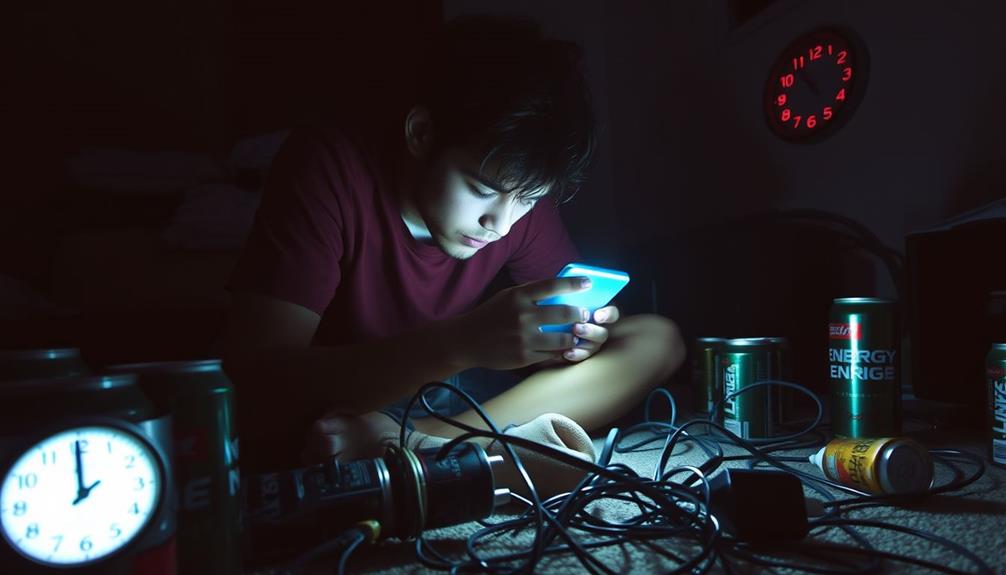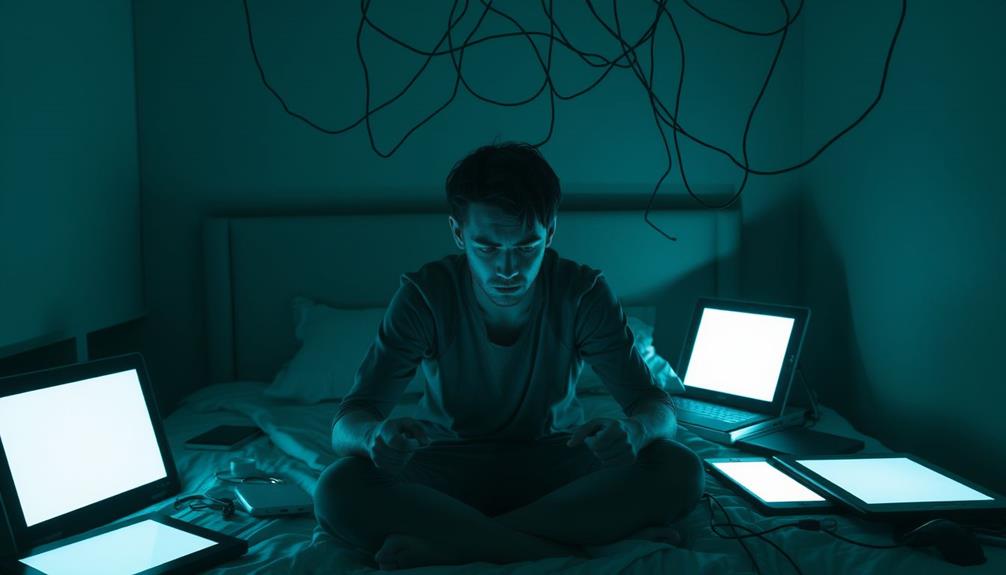If you or someone you know has BPD, recognizing the signs of technology addiction is crucial. Look for mood swings, irritability when offline, and a growing preference for online interactions over face-to-face connections. You might notice feelings of emptiness and neglect of responsibilities due to excessive screen time. These patterns can intensify emotional instability and worsen BPD symptoms. It's important to monitor technology use to prevent escalation. Seeking support and understanding the impact of screen time on mental health can make a difference. Explore how you can manage these challenges effectively and discover helpful coping strategies.
Key Takeaways
- Look for mood swings and emotional instability, which are common symptoms of both BPD and technology addiction.
- Notice a preference for online interactions over face-to-face relationships, indicating potential reliance on technology.
- Watch for feelings of emptiness and irritability when offline, suggesting a possible addiction to digital devices.
- Be aware of neglecting responsibilities due to excessive screen time, leading to guilt and anxiety.
- Observe if emotional instability worsens with increased technology use, linking both conditions closely together.
Understanding BPD and Its Symptoms

Understanding Borderline Personality Disorder (BPD) is vital for anyone touched by its complexities. This mental health condition affects around 1.4% of American adults and is characterized by emotional instability and impulsive behaviors that can lead to considerable challenges in your life.
Individuals with BPD often experience intense episodes of anger, depression, and anxiety, which can exacerbate feelings of emptiness and worthlessness. If you or someone you know exhibits symptoms of BPD, recognizing these signs can be essential common symptoms of BPD.
Common symptoms include frantic efforts to avoid abandonment and an unstable self-image, which can greatly impact interpersonal relationships. You might find yourself experiencing extreme emotional swings, leaving you feeling empty or worthless. These feelings can sometimes lead to self-harm behaviors, emphasizing the importance of seeking help.
Diagnosis of BPD typically involves a clinical evaluation, but misdiagnosis can occur due to overlapping symptoms with other mental health disorders. Most symptoms manifest during early teenage years, and while they often improve with age, many individuals continue to face challenges into adulthood.
Technology Addiction Overview

Technology addiction, often seen as screen addiction, can greatly disrupt your daily life and mental well-being.
You might notice symptoms like emotional instability and impulsivity, similar to those found in borderline personality disorder.
As you explore this issue, it's essential to comprehend the behaviors associated with excessive screen time and their impact on your mental health.
Additionally, it's important to evaluate the potential for cold medications overview to help manage associated symptoms such as anxiety or restlessness that may arise from technology addiction.
Defining Technology Addiction
Excessive use of digital devices can spiral into what's commonly known as technology addiction, which impacts daily life and mental well-being. This condition, often referred to as internet addiction or screen addiction, is characterized by a compulsive need to engage with devices, leading to neglect of responsibilities and relationships.
As highlighted by philosophical exploration encourages deeper self-reflection, recognizing the underlying motivations for excessive screen time can be essential in addressing this issue. Studies show that around 8% to 26% of college students experience technology addiction, with higher rates in certain areas.
The implications of technology addiction extend beyond mere usage; they greatly affect your mental health. If you find yourself feeling emotional distress when you're offline or unable to resist the urge to check your phone, you might be experiencing the symptoms of behavioral addiction.
Research indicates that technology addiction can exacerbate existing psychological issues like anxiety and depression, particularly in individuals predisposed to these conditions.
Interestingly, gender differences have emerged, with men generally reporting higher levels of screen addiction than women. Understanding these dynamics is essential for developing targeted intervention strategies.
Recognizing the signs of technology addiction is the first step toward regaining control over your digital habits and nurturing your mental health.
Symptoms and Behaviors
Recognizing the signs of technology addiction is essential in addressing its impact on mental health. You might notice symptoms like mood swings and emotional instability that mirror those found in borderline personality disorder (BPD). These fluctuations in your emotions could lead to impulsiveness, prompting you to seek immediate gratification through excessive screen time.
As with emotional and psychological growth, the influence of environmental interactions can shape your response to technology key domains of development.
As you dive deeper into the digital world, you may find yourself neglecting responsibilities and preferring online interactions over face-to-face relationships. This shift can foster social isolation, making you feel increasingly disconnected from those around you.
Additionally, feelings of emptiness often accompany this lifestyle, as the fleeting satisfaction from technology fails to fill the void.
If you experience irritability or distress when you're offline, it could be a sign of technology addiction. This negative emotional response is particularly pronounced for individuals with BPD, emphasizing the need for awareness and intervention.
Impact on Mental Health
The impact of technology addiction on mental health can be profound and far-reaching. If you struggle with borderline personality disorder (BPD), excessive screen time can markedly worsen symptoms like mood swings and emotional instability.
Research shows that individuals with BPD often face heightened psychological distress, leading to increased anxiety and depression, especially when their technology use spirals out of control. Additionally, as technology continues to advance, the demand for roles such as AI ethicist jobs emphasizes the significance of understanding the ethical implications of technology, which can serve as a reminder of the need for balance in our digital lives.
Men, in particular, tend to report higher levels of screen addiction compared to women, which may require tailored mental health interventions. The negative consequences of technology addiction can mirror those of substance addiction, manifesting as neglect of responsibilities and emotional distress when offline.
This can severely impair your relationships and overall well-being. Recognizing the detrimental effects of technology addiction on mental health is vital. By becoming aware of how your screen time impacts your emotional state, you can promote self-regulation and adopt healthier technology use practices.
It's important to find a balance that supports your mental health rather than detracts from it. Taking steps to manage technology use can lead to improved emotional stability and a healthier relationship with both yourself and others.
Signs of Technology Addiction

You might notice signs of technology addiction if you find yourself using screens to escape emotional instability or impulsivity.
Engaging in excessive online activities can lead to neglecting your personal finances, including the importance of maintaining a budget.
If responsibilities start slipping while online interactions take precedence over real-life connections, it's a red flag.
Recognizing these patterns early can help you take control before they escalate.
Emotional Instability and Online Use
Many individuals with borderline personality disorder (BPD) struggle with emotional instability, which often drives them to seek refuge in the online world. This coping mechanism can lead to technology addiction, as the internet offers an escape from intense feelings of emptiness and interpersonal turmoil.
Engaging in online interactions may temporarily alleviate emotional distress, but it can also hinder personal growth and creativity, as seen in the Power of Imagination.
You might notice signs of this emotional connection to online use through:
- Compulsive Checking: You find yourself frequently refreshing social media feeds, seeking validation and reassurance to combat feelings of abandonment.
- Idealization and Disappointment: Your emotional swings cause you to oscillate between viewing online interactions as perfect and feeling deeply let down when they don't meet your expectations.
- Neglect of Real-Life Responsibilities: As you immerse yourself in online behaviors, you may unintentionally ignore responsibilities and relationships, allowing impulsivity to take over.
Awareness of these patterns is essential. Recognizing how emotional instability fuels your technology addiction can empower you to take steps toward healthier coping mechanisms, ultimately leading to more meaningful real-world connections and emotional stability.
Impulsive Behavior and Screen Time
Impulsive behavior often intertwines with excessive screen time for those with borderline personality disorder (BPD), creating a cycle that can be hard to break. You might find yourself drawn to technology use as a way to escape emotional instability, leading to screen addiction. This pattern not only fuels impulsive behavior but also exacerbates feelings of anxiety and depression.
| Signs of Impulsive Screen Time | Potential Consequences |
|---|---|
| Frequent social media browsing | Increased emotional instability |
| Late-night gaming | Neglect of responsibilities |
| Impulsive online purchases | Strained relationships |
| Skipping work for screen time | Heightened feelings of guilt |
As you spend more time online, you may neglect important responsibilities, further complicating your life. Research shows that this relationship between impulsivity and screen addiction is particularly pronounced in individuals with BPD. Men, in particular, report higher levels of screen addiction than women, highlighting gender differences in technology-related impulsivity. Recognizing these signs can be the first step toward breaking free from this cycle and regaining control over your life.
Neglecting Real-Life Responsibilities
Neglecting real-life responsibilities often becomes a significant issue for those struggling with technology addiction, especially individuals with borderline personality disorder (BPD).
You might find yourself prioritizing screen time over essential commitments like work, school, or personal relationships. This neglect can lead to emotional distress, affecting your mental health and creating a cycle of anxiety and depression.
Additionally, just as early detection is imperative in healthcare, recognizing the impact of technology on your life can help in addressing these challenges more effectively early detection strategies.
Here are three signs that you may be neglecting your responsibilities due to technology addiction:
- Diminished Productivity: You may notice tasks piling up at work or school, as you spend more time on screens than addressing your obligations.
- Strained Relationships: Friends and family might express concern that you're often unavailable, choosing to engage with technology rather than connect with them.
- Overwhelming Guilt: As responsibilities accumulate, feelings of guilt can arise, making it even harder to manage your daily tasks.
For many young adults, this cycle is especially detrimental, as it exacerbates symptoms of BPD and contributes to deteriorating mental health.
Recognizing these signs is the first step toward reclaiming balance in your life.
BPD's Role in Technology Addiction

Borderline Personality Disorder (BPD) can greatly impact how individuals engage with technology, often leading them to turn to screens as a way to cope with emotional turmoil.
If you have BPD, you might find that emotional instability drives you to seek solace in the digital world, which can result in Internet addiction. This compulsive tech use often serves as a maladaptive mechanism to escape feelings of emptiness and anxiety.
Some individuals may even find themselves drawn to uplifting music, like Blue Skies and Lemonade by Rhythm Failure, which can provide temporary relief from emotional distress.
Research shows a strong correlation between the severity of BPD symptoms and Internet addiction, emphasizing the need to address technology use in therapy.
Your impulsivity may lead to excessive screen time and compulsive online behaviors, creating a cycle of addiction that exacerbates your emotional distress.
Furthermore, if you're among the nearly 47% of individuals with BPD facing co-occurring substance use disorders, the relationship with technology becomes even more complicated.
Mental Health Implications

Excessive screen time can considerably affect your mental health, intensifying symptoms like mood swings, impulsivity, and emotional instability. If you're struggling with borderline personality disorder (BPD), screen addiction can worsen your psychological distress, leading to increased anxiety and depression.
It's vital to recognize these implications, especially since technology often takes precedence over real-life relationships, causing you to neglect important responsibilities. Additionally, incorporating practices like mindfulness and yoga can help manage emotional responses and improve overall well-being, offering a holistic approach to mental health yoga for back pain.
Here are three key mental health implications of screen addiction related to BPD:
- Emotional Instability: The constant stimulation from screens can heighten your emotional reactivity, making it harder to manage feelings effectively.
- Social Isolation: Preferring online interactions can deepen feelings of loneliness and disconnect from others, exacerbating BPD symptoms.
- Neglected Responsibilities: Excessive use of technology may lead to a decline in daily functioning, impacting work, relationships, and self-care.
Understanding the link between screen addiction and mental health is significant. It highlights the need for targeted interventions to address these intertwined issues, ensuring you find healthier ways to cope and engage with the world around you.
Coping Strategies for Affected Individuals

In today's digital age, finding effective coping strategies is essential for individuals affected by technology addiction, especially those with BPD. Establishing structured routines that limit your technology use can greatly reduce impulsivity and the emotional distress associated with excessive screen time.
You might find it helpful to set specific time limits for your device usage, tracking your screen time with apps to gain a clearer understanding of your habits.
Mindfulness techniques are also powerful tools for managing anxiety and emotional triggers stemming from technology. By practicing grounding exercises, you can foster greater control over your impulses.
Engaging in face-to-face social interactions rather than relying on online communication can enhance your interpersonal relationships, helping to alleviate feelings of loneliness.
Lastly, don't hesitate to seek support from mental health professionals who understand the complex interplay between BPD and technology addiction. They can offer tailored coping strategies that suit your unique situation, promoting healthier behaviors and emotional resilience.
Treatment and Support Options

Finding the right treatment and support options is essential for anyone grappling with technology addiction and BPD. Effective treatment programs often include cognitive-behavioral therapy (CBT) and dialectical behavior therapy (DBT), which help you develop healthier coping mechanisms and manage impulsive behaviors.
An integrated approach can greatly enhance your mental health outcomes by addressing both BPD and technology addiction simultaneously.
Here are three key options to reflect on:
- Therapeutic Interventions: Engage in DBT or CBT to learn skills for emotion regulation and decreasing reliance on technology.
- Support Groups: Join community support groups where you can share experiences and gain insights from others facing similar challenges.
- Educational Programs: Participate in programs focused on promoting healthy technology use and raising awareness about the risks of excessive screen time.
Additionally, professionals recommend regular monitoring of screen time to help you maintain healthy digital habits and prevent relapse into addictive behaviors.
Importance of Early Recognition

Recognizing technology addiction early can greatly impact individuals with Borderline Personality Disorder (BPD). When you identify the signs of addiction, like excessive screen time and withdrawal from real-life relationships, you can intervene before these behaviors worsen.
BPD symptoms, such as emotional instability and impulsivity, can be exacerbated by technology addiction, making early recognition essential for effective management.
Studies show that individuals with BPD often feel empty and lonely, leading to increased reliance on technology for social interaction and emotional regulation. This reliance can create a vicious cycle, complicating both diagnosis and treatment.
For men with BPD, screen addiction rates tend to be higher, highlighting the need for tailored interventions based on gender-specific patterns.
Conclusion
In summary, recognizing the signs of technology addiction, especially in those with BPD, is essential for effective intervention. Did you know that studies show individuals with BPD are 50% more likely to develop technology-related addictions? By understanding this connection, you can take proactive steps to manage your relationship with technology. Remember, reaching out for support and implementing coping strategies can make a significant difference in your mental health and overall well-being. Don't hesitate to seek help!
Theresa is the visionary force behind Borderline Syndrom, steering our content towards excellence and integrity. With a keen eye for detail and a deep understanding of BPD, she ensures that our articles, stories, and resources offer our readers valuable insights, hope, and guidance. Theresa’s leadership not only shapes our editorial direction but also fosters a space where voices on BPD are heard and respected.










